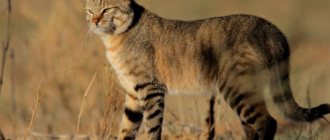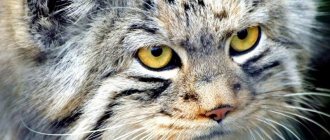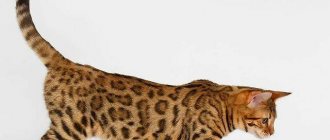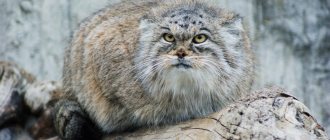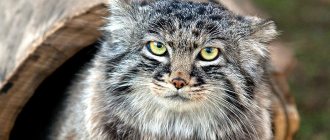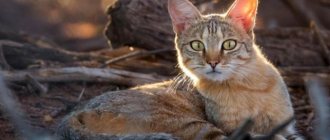01 March80031wild catsmanulpredatorPallas cat
The wild cat Manul is a predatory representative of small cats from the Felidae family. Manul is an interesting and unusual animal. The manul cat is smart, careful and secretive. The Pallas cat is also called the Pallas cat. In this article you will find a description of the Pallas's cat and its photo, and you can also learn a lot of interesting things about the amazing animal with the mysterious name Pallas's cat.
Description of the breed, appearance of the cat
Externally, representatives of wild cats do not differ from an ordinary domestic cat.
Pallas's cat (manul) - one of the most unstudied representatives of wildlife
But the manul also has its own unique characteristics:
- Strong physique.
- The muzzle is flattened.
- Short legs. When winter comes, the animal's body becomes overgrown with fur, and its paws become invisible.
- Bright yellow eyes, round in shape. The look seems evil.
- The coat is gray with lightened tips. There are dark stripes throughout the body, the tip of the tail is black.
Several subspecies of cave cats are known. All these animals are similar. Representatives differ only in the color of their skin.
Simple manul
The color is gray, as described above. In nature, the species is found in Mongolia, China, and Siberia. This variety was the first to be discovered.
Central Asian
A distinctive feature of the species is its red color with red stripes. The cat's homeland is the Middle East.
Tibetan
The color is silver-gray. In summer the fur coat becomes darker. The predator lives in Tibet, Uzbekistan, India, and Nepal.
Amur tiger
Despite conservation measures, the population of the Amur tiger is recovering very slowly.
It is also Siberian, it is Far Eastern, it is also Ussuri. This noble, incredible beast is the largest representative of the cat family and the only one of the tiger species who can survive in the harsh conditions of the Ussuri forests. The population of the ruler of the taiga declined rapidly from the end of the 19th century to the 30s of the last century, until it reached 20-30 individuals! The extermination of the species was facilitated not only by targeted poaching for the beautiful striped skin and other parts of the tiger carcass for further sale to Asian countries, but also by a reduction in the number of ungulates in the tiger’s habitat and active deforestation of taiga areas. As of 2015, according to the tiger census, 520-540 Siberian tigers live in the Russian Far East. The animal is listed in the Red Book and has the status of an “endangered species,” but there is still hope for the Amur tiger.
Hunting and food
Manul is endowed with patience. When hunting, he does not rush, but calmly waits for his prey in ambush. The predator guards near the hole and attacks from the back.
Cats hunt Daurian peeps and small rodents . Animals feed on hares, marmots, and birds. If the hunt is unsuccessful, the cat will be satisfied with prey such as insects. The animal eats plants and berries.
Be sure to read:
A cat that looks like a lynx: the best domestic and exotic breeds, features of their maintenance
A predator attacks at night. In the warm spring and summer, the cave cat loves to bask in the sun, so it hunts during the day.
In zoos, pets are fed rodents and beef.
Chilean cat
Kodkod is an excellent climber and excellent tree climber.
Another predatory baby comes from South America. Its other name is kodkod. The weight of an adult cat is a maximum of 2.7 kg. The species is included in the International Red Book as vulnerable; the population of the species is about 10,000 adult animals. The species is threatened by both poachers and habitat loss (deforestation).
Reproduction of the Pallas cat
If you manage to find an individual of the opposite sex for the Pallas's cat, then at home it will be quite difficult to wait for the offspring to be born. In captivity, predators rarely breed.
Puberty in a cave cat occurs at 9-10 months. The mating period lasts from late winter to early spring. Fertilization occurs once a year, and females carry babies for 2 months.
From 2 to 5 kittens are born at a time. All offspring fail to survive. Little Pallas cats are dying from infectious diseases.
Wild kittens, like their domestic relatives, are born blind and begin to see after 2 weeks. When the babies are 4 weeks old, they go hunting.
Clouded leopard
The clouded leopard is one of the ancient species of cats.
The beautiful spotted-marbled coat of the clouded leopard, which lives in the tropical forests of southeast Asia, is still a valuable prey for poachers. Deforestation also played an important role in reducing the species' population. As of 2008, the clouded leopard population numbered 10,000 adults and is considered endangered. A subspecies of the clouded leopard, the Taiwan leopard, was already declared extinct in 2013.
Range, environment and habitats
In nature, the life cycle of a predator reaches 12 years.
The favorite habitat of animals is steppe and semi-desert. Cats also feel good in mountainous areas.
The predator has sharp claws, so it is able to dig a home on its own. However, representatives of the breed love to settle in caves, in abandoned burrows of other animals - badgers, foxes.
Predators climb onto higher rocks, choosing a dwelling no lower than 4 km above sea level. The main thing is that the animal can hide from prying eyes.
The cats spend the whole day in the shelter, and at night they go out to hunt.
Where does the manul live?
The homeland of the Pallas's cat is: Mongolia, Tibet, China, Transbaikalia, Kashmir, Asia.
In Russia there is only one species - the simple manul.
Natural enemies
The greatest danger to Pallas cats is people and set traps. Animals die in the clutches of hunting dogs, wolves, and foxes.
Be sure to read:
Cheetah-like cat breed: Serval (bush cat, or African cat)
Their numbers are also affected by cold winters and a decrease in the rodent population.
How Pallas's cat behaves in its natural habitat
The greatest danger for Pallas cats is the
Manul, who is slow by nature and gets tired quickly. The cat has short legs, which is why the predator moves slowly. Therefore, he prefers not to meet with enemies and lurks in shelter all day.
If he is in danger, the cat will still not run away. He prefers to hide and wait until the enemy disappears from the horizon, and if attacked, he will fight back.
Is it possible to keep Pallas' cats in captivity?
The Pallas cat breed is problematic to keep at home . If you provide him with enough space and good nutrition, the animal will still not feel happy. And the owner will not enjoy such a neighborhood.
Keeping a predator at home is difficult for 2 main reasons:
- The cat has a wild disposition. At 4 months, the baby exhibits hunting instincts. He begins to attack the owner, sinking his teeth and claws into him. You can't count on friendship and affection. If you raise a pet from birth, you still won’t be able to restore a weak emotional connection with it. Aggression is inherent in the baby.
- Small representatives of the Pallas' cat breed often get sick at home and suffer from toxoplasmosis. But it is not easy to find specialists who will undertake their healing. After all, the methods of treating a wild cat are completely different from the methods of treating a domestic animal. And approaching a pet is not easy. He is aggressive and will not give in, no matter how bad he feels.
But today there are 50 individuals of this species living in zoos around the world. Moreover, they live there longer than in the wild.
Mr. Cat explains: who is the Steppe Cat and what subspecies he has
To figure out who the Steppe Cat is, we need to consider the entire species of Felis Silvestris, which in Russian is called Forest, and in English simply Wildcat. This scientific name was given to the species in 1777 by Johann von Schreber, when he first described the European forest cat based on the work of earlier naturalists such as Mathurin Brisson, Ulysses Aldrovandi and Conrad Gessner.
In the 1940s, taxonomist Reginald Innes Pocock examined a collection of skins and skulls of these predators at the Natural History Museum in London and identified subspecies of forest and steppe cats. Hence, all subspecies of Felis Silvestris are conditionally divided into two large groups, namely European forest cats (silvestris) and steppe cats (libyca), which in turn can also be conditionally divided into their own subspecies. More details below.
Silvestris group (forest cats):
- F. s. caucasica (Satunin, 1905) or Caucasian forest cat. Lives in the forests of the Greater and Lesser Caucasus. With the exception of the countries of the former USSR in Turkey (Asia Minor).
- F. s. grampia (Miller, 1907) or Scottish forest cat. As the name implies, it lives in Scotland, in its northern part.
- F. s. silvestris (Schreber, 1777) or Central European forest cat. It lives throughout Europe, but is fragmented, with the exception of Scotland, the Mediterranean islands, and Holland. Also extinct in Austria, but now found there as well due to spread from Italy to the north.
Transitional group silvestris-libyca:
Why transitional? The fact is that previously these subspecies were considered as part of libyca, i.e. steppe cats, and now as part of silvestris, i.e. forest
- F. s. cretensis (Haltenorth, 1953) or Cretan wild cat. Lives exclusively on the island of Crete. The subspecies was considered extinct, but an expedition from the Italian University of Perugia in 1996 managed to catch one individual, which was subsequently released into the wild with a radio transmitter. Later, a nest with kittens was found in the Rouvas forest.
- F. s. jordansi (Schwarz, 1930) or Balearic wild cat. It lives on the Balearic Islands, previously it was believed that on all of them, but now only on Mallorca.
- F. s. reyi (Lavauden, 1929) or Corsican wild cat. Lives on the island of Corsica.
Previously, this entire group was called F. s. sarda (Lataste, 1885). Moreover, at different times only cats living in Sardinia had this name, then in Sardinia and Sicily, and after that all 4: cretensis, jordansi, reyi and sarda.
The libyca group (i.e. the steppe cats themselves), they are further divided into two: ornata-caudata and ornata-libyca.
- ornata-caudata (steppe cats) differs from forest cats in their smaller size, lighter fur color and longer and thinner tails. The domestic cat is thought to have evolved from this group.
- F. s. caudata (Gray, 1874) or Turkestan steppe cat. It lives in Central Asia, Kazakhstan, Eastern Transcaucasia, northern Iran and Afghanistan, southwestern Mongolia and northwestern China. Since the end of the last century it has also been found in Russia.
- F. s. gordoni (Harrison, 1968) or Omani wild cat. Lives on the Arabian Peninsula, Oman and the northeastern part of the UAE. Very small, they easily interbreed with ordinary domestic cats, which leads to the extinction of the subspecies.
- F. s. iraki (Cheesman, 1921). Lives in Kuwait and Sheikh Saad on the Tigris River, Iraq.
- F. s. nesterovi (Birula, 1916). Approximate habitats: Mesopotamia and southern Iran, borders unknown.
- F. s. ornata (Gray, 1832) or Asian steppe (desert) cat. It lives throughout Pakistan, in the western and central parts of India south of the Ganges.
- F. s. tristrami (Pocock, 1944). Lives in Palestine, as well as in the west and south of Arabia.
- ornata-libyca (damn cats). It is distinguished by lighter fur, well-developed dot patterns and stripes.
- F. s. foxi (Pocock, 1944). It lives in western Africa (Paniam plateau, Bauchi province, northern Nigeria).
- F. s. haussa (Thomas and Hinton, 1921). Lives in the Sahara (Chad, Niger, Nigeria, western Sudan (Darfur deserts).
- F. s. cafra (Desmarest, 1822) or South African wild cat. It is found, as the name suggests, in southern Africa.
- F. s. griselda (Thomas, 1926). Habitat: southern Angola, Namibia, Botswana.
- F. s. mellandi (Schwann, 1904). Lives in Central Africa.
F. s. griselda
F. s. mellandi
- F. s. rubida (Schwann, 1904). Lives in Congo.
- F. s. ugandae (Schwann, 1904). It lives in the south of Sudan, Congo, Uganda, Kenya, and Lake Tanganyika.
- F. s. lybica (Forster, 1780) or African steppe cat. Lives in semi-desert regions of northern Africa.
- F. s. ocreata (Gmelin, 1791). Lives in Ethiopia.
Thus, there are 15 subspecies of Steppe cats.
However, now a simplified system is increasingly used, where not groups are considered, but simply subspecies (ornata-caudata is mixed with ornata-libyca):
- F.. s. lybica - African. The species and nominate subspecies have pale, whitish or light grayish fur tinged with red on the spinal stripe, and its pointed tail is about two-thirds the length of the head to the size of the body.
- F. s. cafra - South African. Slightly different in color and pattern from the nominate species. In existing zoological specimens, the skulls are slightly longer than in northern African specimens.
- F. s. ornata - Asian. The animals have dark spots on their light, ocher-gray fur.
- F. s. silvestris - European and transitional. They have dark gray fur with distinct transverse stripes on the sides and a bushy tail with a rounded black tip.
Also often included here are Felis bieti, Chinese mountain cats.
The spotted cat is a member of a family that descended from a common ancestor about 10-15 million years ago. Felis species diverged from it about 6-7 million years ago. The European subspecies formed from 1.09 to 1.4 million years ago.
The direct ancestor of the European forest cat was Felis lunensis, which lived in Europe during the late Pliocene and Villafranchian period. Fossil remains indicate that the transformation from lunensis to silvestris was completed by the Holstein Interglacial Period 320-340 thousand years ago.
Craniological differences between the European and African cats indicate that their ancestor likely migrated during the late Pleistocene from Europe to the Middle East, resulting in a new phenotype.
Manul at home
If anyone decides to keep a predator at home, then it is worth trying to place the pet in the private sector. Bushes and trees growing in the yard will remind the animal of natural conditions.
The Pallas cat breed is problematic to keep at home
The cat will be able to hunt at night, which cannot be done in an apartment.
Important ! It is not recommended to enter the territory of the Pallas' cat. The animal will begin to defend the territory and rush to attack. You should not expect that the cat’s plans to attack will become known in advance, because he always walks around with a malicious and aggressive face.
The Pallas' cat does not need any special care. There is no point in trying to teach a predator to bathe, it is impossible. The pet responds adequately to the combing procedure. And the predator has big problems with fur. A cat is in the molting stage all its life.
Be sure to read:
Is it possible to tame a Pallas's cat: how to keep and care for it, possible problems, what not to do
Bornean clouded leopard
The Bornean leopard is active mainly at night.
Despite its similar name to the previous leopard, the Bornean or Kalimantan leopard is not a subspecies of it. The Bornean leopard lives in the rain and mangrove forests of Borneo and Sumatra. There is no reliable data on its abundance, but the species is classified as vulnerable due to degradation and transformation of wooded areas, which are the habitat for this species, into rubber plantations.
Interesting facts about the Pallas cat breed
This is interesting:
- Evolutionary processes did not affect the appearance of the cat.
- Pallas named the cat "Otocolobus", which means "ugly ears". In fact, they are truly unusual, but calling an animal's ear ugly is wrong.
- The little kitten doesn't know how to meow. Predators communicate using harsh calls.
- Among the cat representatives, the Pallas's cat has the thickest fur. There are 10,000 hairs on 1 square centimeter of animal skin.
- The predator calmly tolerates temperatures of -50 0C.
- Due to the hermit's lifestyle, the animal's immune system is weakened. Pallas cat can easily become infected from domestic cats.
Sumatran cat
The flat-headed cat is very cautious and is predominantly nocturnal.
Another wild cat from southeast Asia is the flat-headed or Sumatran cat. It was considered extinct in the mid-1980s, but was rediscovered in Malaysia in the 1990s. This cat is very tiny (1.8-2.7 kg) and prefers to settle near the water, where you can splash around happily and feast on fish, frogs, and other tasty aquatic inhabitants. The flat-headed cat is active at night and is usually not visible to people, so the species has been little studied. There is information that the last meeting of a person with this cat was in 2005. There is no data on the number of livestock, but the Sumatran cat is listed in the International Red Book as an endangered species due to pollution of water bodies, destruction of habitats and depletion of fish resources.
Sumatran tiger
The Sumatran tiger is very ferocious and can attack people.
It is endemic to the island of Sumatra, located in the western part of the Malay Archipelago. The Sumatran tiger is the smallest representative of the tiger species, but the most aggressive. The species is small in number and is endangered due to illegal hunting and habitat destruction. The cost of a Sumatran tiger carcass on the black market is $20,000. Sumatran tiger attacks on humans are not uncommon: at least 8 people have been killed by them since 2002. Listed in the International Red Book and the CITES Convention.
Source
Far Eastern leopard
The Amur leopard reproduces extremely poorly in captivity.
The rarest subspecies of leopard is on the verge of extinction and is included in almost all protection documents. In the Primorsky Territory National Park “Land of the Leopard” there are only 87 individuals (as of 2017), about 12 more adult animals are in China. Huge damage to the Far Eastern or Amur leopard was caused by poachers. The illegal shooting of animals was caused by the widespread demand for skins and other parts of carcasses, which are used in oriental medicine, as well as unemployment and poverty of the population of the Primorsky Territory. The species is threatened by a reduction in the number of ungulates, habitat degradation and inbreeding, which causes genetic depletion of the species (due to a small population).
Iriomotean cat
The Iriomote Island cat is a subspecies of the Bengal cat.
An extremely rare species that is endemic to the subtropical Iriomote Island, part of Okinawa Prefecture, Japan. This cat originally had a limited range and an extremely modest population. At the moment, the number of Iriomotey cat is no more than 100 adult individuals.
Some locals consider its meat a delicacy, which greatly harms the species. Crossbreeding with wild cats of other species also contributes to the decline of the Iriomotean cat. The species is on the verge of extinction, therefore it is protected and listed in the International Red Book.
